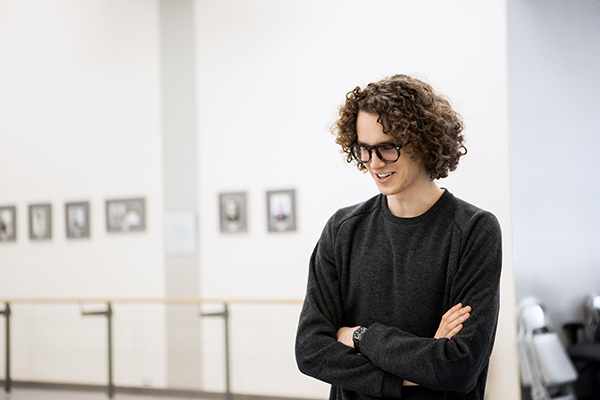Ballet
Nouvelles+
Making the Unreal, Real and the Dead, Alive
by Susan Walker
23 septembre 2019

Choreographer Robert Binet is what you might call a forward-thinking traditionalist.
When The National Ballet of Canada’s Choreographic Associate came to Artistic Director Karen Kain five years ago with the idea of making ballet based on the Greek myth of Orpheus and Eurydice, he knew that story was so familiar to audiences that it would allow him the freedom to play with its themes in a contemporary context.
In the myth, the musician Orpheus descends to the Underworld to persuade the gods to release his late wife Eurydice to him. He is granted his wish to rescue her, provided he never looks back at Eurydice during their ascent to Earth. If he does look, he will lose her forever.
Binet was drawn to the myth by a central theme: “It was the concept of not being able to look at someone you love and if you do, losing them forever.” He sought a human reason for why Orpheus couldn’t be with Eurydice – and not just a curse placed by the gods. “What makes it too painful, what makes it too scary, what makes it too dangerous?”
Binet began to develop the ballet as a parable of the artist and the power of art to persuade and transform – and, Binet’s Orpheus would be the female.
After Kain gave him the green light to develop Orpheus Alive, the first person Binet called was the New York composer Missy Mazzoli. “Because the Orpheus story is about the power of art, the music had to be amazing.”
Binet had previously made contact with Mazzoli, with a determination to collaborate with her one day. Back in 2012 while working in London, the music publisher Schirmer gave him a stack of CDs from their composers to listen to. He stopped sampling after hearing Mazzoli’s music. “I remember putting her CD into the player in my apartment and it gave me this sensation of being knocked flat on my back and wanting to get up and dance around at the same time, which is sort of the thing that only Tchaikovsky in ballet music really does – where it’s so big that you’re at once flying and being run over by a truck. Missy can do that with a really contemporary sound, which is rare.”
An artistic residency at Banff Centre for Arts and Creativity in 2015 gave Binet the opportunity to explore ways of making the Orpheus story new. He worked with four National Ballet dancers and with existing music by Mazzoli. “We tried duets every which way to see what was most exciting to us and we ended up with Orpheus as a woman and Eurydice as a man.”
As Binet explained in a 2015 TEDx talk, “In classical ballet partnering technique, the man almost always partners the woman from behind the woman and lifting someone is incredibly difficult if you’re not allowed to look at them. So I thought wouldn’t it make more sense if the one leading was the woman, without looking back?”
Binet’s Orpheus would emerge as a powerful female protagonist who happens to be an artist. “She’s very vital, she’s fighting for something the whole time; she’s not in any way a passive character.”
With this switch, Eurydice became a male character who’s vulnerable and fragile and ghostly, almost Giselle-like. The possibilities for drawing a different kind of physicality out of classically trained male and female ballet dancers inspired Binet.
Orpheus Alive is set in the present, where the Underworld is a seat of power whose entrance is guarded by a three-headed monster (performed by three dancers), updated as a mean bureaucrat. Orpheus must make her plea using her art – in this case dance – to persuade the gods to give her back her dead lover Eurydice.
“I’m not trying to flip the dance vocabulary,” says Binet. “My goal is to tell the story in a way that makes sense out of the vocabulary. I think in all my work the partnering is much more equal. With sharing of weight, the women are a real driving force in a duet; they’re not just carried around. However, I don’t want to get rid of men lifting women over their heads, because it’s thrilling and it’s beautiful and part of what makes ballet so exciting.”
The cast is huge: 45 dancers, including main characters Orpheus, Eurydice and Eurydice’s mother, along with a large chorus who take on different roles including mourners, furies, underworld spirits and sometimes echoes of Orpheus and Eurydice, who will be deployed on a set collaging the different landscapes in which the action takes place.
With Mazzoli, as well as librettist and dramaturge Rosamund Small, set and costume designer Hyemi Shin and lighting designer Tom Visser, Binet feels his creative team has been totally integrated as collaborators with a common artistic goal.
The takeaway should be that this is what performing is all about. “We can make the unreal real and make the dead alive,” says Binet. “This is what we do in theatre.”
Orpheus Alive & Chaconne is onstage 15 novembre – 21, 2019.
